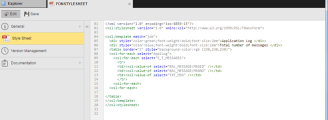 Style Sheet Object (XSL)
Style Sheet Object (XSL)
Certain reports, particularly some SAP reports, can be very long and complex. Style Sheet objects provide the necessary code to modify their layout to make it user-friendly. In a standard installation, client 0 comes with predefined Style Sheet objects that provide SAP reports with an easy-to-read layout.
Object Definition
Object class: Passive object
Object type/Short form: XSL
This topic provides information on the following:
When defining an SAP job you can specify which additional, SAP-specific reports should be generated. These reports can be long and complex. In a standard installation, client 0 is supplied with the following ready-to-use Style Sheet objects in the Stylesheets folder:
XSL.SAP.APPLICATIONLOGXSL.SAP.JAVASTATISTICSXSL.SAP.SPOOLDIRECTORYXSL.SAP.STATISTICSXSL.SAP.STEPLIST
They contain the necessary code to format the reports and give them a user-friendly layout.
Each object corresponds to a specific SAP report. By default, they are already assigned to their respective report types in the UC_REPORT_STYLESHEETS variable (see UC_REPORT_STYLESHEETS - Style Sheets for XML Reports).
You cannot display a report with a style sheet if
- no Style Sheet object has been assigned to the report type.
- the report has not completely been transferred due to an error.
- the report is very long and must be transferred page by page.
- the XML data cannot be correctly parsed.
An Style Sheet object definition is made up of the following pages:
- Standard pages that are always available, no matter what type of object you are defining:
- The object-specific page described here:
You can define your own Style Sheet objects to either modify the layout provided by the standard ones or create completely different ones.
